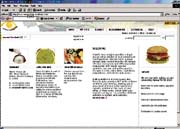
Trends and innovations in foodservice are sometimes evident by simply opening a menu or two. But there is nothing special (or profitable) about spotting trends when everyone else does. Those in R&D, marketing and other disciplines where research is an active ingredient in planning know that the trick to uncovering the latest trends in foodservice is in the tools you use.
Chicago-based Mintel's Menu Insights (www.menuinsights.com) menu tracking database offers rich research capabilities to culinary and marketing types alike. The company's ongoing compilation of menu data from 550 restaurants--which includes the top 350 chain operators, 150 innovative independents and the top 50 independent chefs--tracks current and historical menu data and offers a user-friendly but robust tool to create customized charts, graphs and reports based on the latest menu data.
We all know that a database is only as good as the information it contains. To Mintel's credit, a perpetual effort by a dedicated Menu team at Mintel's headquarters in Chicago is constantly capturing the most recent menu data--from pricing to parmesan--and is specially trained to classify applications with great detail.

Getting to Know Macrotrends
The Menu Insights database allows users to construct search definitions on a variety of variables, creating completely customized results. The database provides subscribers with a global view of the foodservice marketplace, allowing users to search for macrotrend results across all 550 operators.In a global search, the database identifies the most frequently menued flavors. The top five, excluding sensory descriptors such as spicy or sweet, are: garlic (2,482 incidences on 550 menus), honey (652), barbecue (502), lemon (387) and herb (371.) By drilling down by foodservice operator segment, these flavor trends vary dramatically. This drilled-down segment search shows that garlic appears most frequently on the menus of family/midscale and casual dining operators compared to the industry as a whole.
Mintel's GNPD database--which tracks new product activity in the U.S. and globally--shows the popularity of these five flavors follows a similar pattern in terms of the proportion of new food and beverage products launched in the U.S. that contain each flavor type. Similar to the Menu Insights results, garlic appeared most frequently (1,490 times between November 2003 and November 2004) out of the five flavors.
While analysis of macrotrends is by all means important, identification of microtrends (by segment or application type) is usually a more mission-critical activity. Obviously, the sooner these trends are identified, the better.
Making the Most of Microtrends
One way to consider where microtrends are going is to unearth where they began. The Menu Insights team at Mintel processes new menus on quarterly basis, making microtrend tracking over time a reality. While some trends stick, many end up sinking.The big question is whether emerging trends such as the Californian- or Cuban-styled applications will follow in the same footsteps of Tex-Mex--a trend that stuck. Mining for microtrends is always a daunting task but, nevertheless, a worthwhile endeavor, especially when using the right search tools.
While Cuban-style is still a microtrend, Menu Insights shows that California-style application positioning is becoming a trend with sticking power. Of the 550 chain and independent operator menus in the Menu Insights database, nearly 11% use the “California” positioning to describe at least one application. Menu-ing instances range from Red Robin's (Greenwood Village, Colo.) California Chicken Burger to McDonald's (Oak Brook, Ill.) California Cobb.
Sophisticated search tools are a cornerstone of Mintel's Menu Insights, allowing subscribers to identify and track the potential of microtrends in the foodservice industry.
Turning Menu Trends into Business Results
No self-respecting culinary ace would ever want his work to become “ordinary.” Meanwhile, marketers dream of the day when their projects flow through the foodservice market like ketchup. Despite this difference in semantics, ordinary--in the foodservice context--means mainstream adoption, repeat orders and satisfied customers. Success is aligning menus with consumer demand.Believe it or not, consumers demand ordinary more than they do innovative. But that does not mean that mainstream applications cannot be extraordinary.
Only a handful of foodservice trends go from niche to mainstream, but the ones that do are the result of widespread consumer adoption. Consumers beheld the wrap--a trend that debuted years ago and still has a home in most of the leading foodservice operator segments. This alternative to the sandwich is a prime example of sticking power. Menu Insights provides a platform to keep up with these emerging trends from the start and leverage the velocity of trends that have the power to redefine menus across the nation.
Capitalizing on trends means hearing about them first. In addition to world-class support from the Mintel Menu team, the Menu Insights menu tracking platform offers subscribers automated search and tracking capabilities. Industry participants with access to Menu Insights should certainly take advantage of the database's personalized e-mail alerts, editorial perspectives, quarterly menu reports, advanced charting and graphing capabilities, and Mintel's responsive account management team.